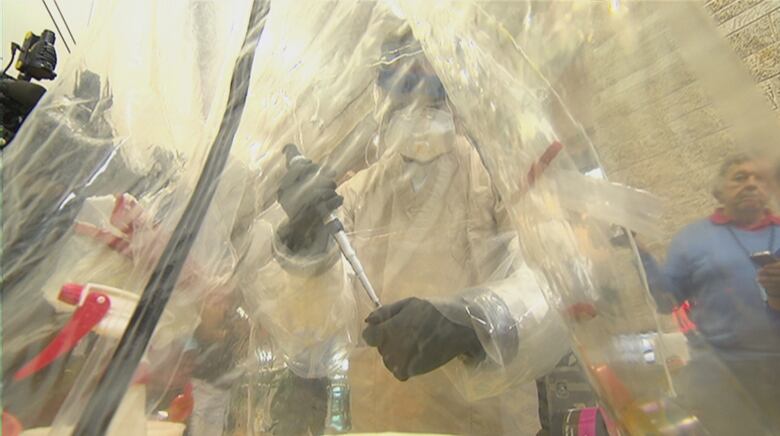Workers may have been exposed to Ebola, HIV and TB at Winnipeg lab, reports reveal
Though risk of infection considered low, 'no exposure at all is acceptable,' says lab doctor

More than a dozen employees may have been exposed to potentially dangerous pathogens in incidents at Winnipeg's National Microbiology Laboratoryover a 22-month period.
There were 14 cases involving possible exposures in 45 incident reports between January 2015 and October 2016, which were released under an access to information request.
Those incidents include problems with biosafety suits, contaminated needle pricksand equipmentmalfunctions which led to individuals coming into contact with samples of HIV, Ebola and tuberculosis, among other contaminants.
In each of these cases, the risk of infection was considered "low," "very low" or "negligible" by on-call infectious disease physicians.
"Any incident should be the last one," said Dr. Gary Kobinger, an infectious disease expert who used to work at the lab.
Kobinger said working with deadly pathogens does carry some degree of risk but proactive safety protocols and followup after each case minimizes therisk of an incident happening again.
None of the incidents in this period resulted in an employee becoming infected, according to Dr. Matthew Gilmour, scientific director general of the National Microbiology Laboratory's Public Health Agency.
However, Gilmour said an incident in 2012 did result in a "probable laboratory-acquired infection" in a Level 2 lab. The employee recovered fully.

"There might be an appearance that there's a high volume of incidents within the lab, but it's reflective of the transparency in the processes we have to just improve the quality of the lab as a whole," said Gilmour.
Some of the exposures in the reports were due to problems with safety gear.
In one case, an employee was exposed to the Ebola virus while pressure-washing a cage that previously held an infected animal. The employee was wearing a biosafety suit, but after a few minutes noticed water leaking in.
The leak seemed to have happened in a spot where the suit had previously been repaired, the incident report says. The suit had passed the lab's safety test just two days earlier.
Another faulty biosafety suit resulted in potential Ebola exposure for another employee just over a year later.
Several employees were exposed to avian influenza virus, or "bird flu," while handling wild ducks. The ducks had been captured and brought to the lab to be infected with the virus for research tests.
Employees had been feeding, watering and clipping the birds' wings without wearing disease protection, assuming the ducks were "clean" animals. The employees soon learned the birds had previously contracted avian influenza in the wild.
Other exposures involved employees handling needles without puncture-resistant gloves. One person risked exposure to HIV when a clean needle slipped and punctured the worker's hand through a contaminated glove.

Another worker couldhave been exposed to scrapie a fatal disease that affects sheep and goats when an infected mouse kicked the needle during an injection, causing it to stab the employee's hand.
In the latter incident, a report stated that this type of accident would not change the way mice are handled during injections.
"Other options for protective equipment to prevent such occurrences have been looked at in the past and have been deemed to impede dexterity and potentially cause greater risk to individuals," the report read.
Kobinger saysthere must be a balance between safety for the workers and the ability to do their jobs.
"Every time you have a new protocol it carries its own risk," he said. "Before you change that protocol you have to think really hard because you might change it in a way that might actually make things more difficult."
"No exposure at all is acceptable" at the lab, saidGilmour, but he's proud of their incident-reporting process and the improvements they allow. New biosafety suit technology is in the works, and Gilmour says the lab is continually looking for upgrades in technology and new suits as they come to market.
"We're always looking for improved personal protective equipment for the staff," he said. "If we find something that is a preferable option, that's something that we can move towards."
Got a tip for the CBC I-Team? Email iteam@cbc.ca or call the confidential tip line at 204-788-3744.













_(720p).jpg)


 OFFICIAL HD MUSIC VIDEO.jpg)
.jpg)



























































































